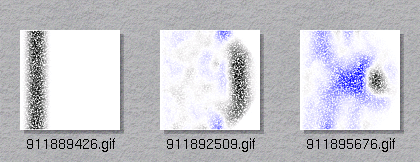Discrete, Amorphous Physical Models - paper from International Journal of Theoretical Physics (also in pdf format)
Animations:
Two-dimensional wave on a torus
Two-dimensional wave, edges fixed at 0
"Refraction" (dense region in center with same average number of neighbors
An example of an irregular lattice:

q (amplitude) is displayed for each site. Colors used:

Two-dimensional wave, edges fixed at 0 [1.6 MB MPEG animation] [GIF animation]
5000 processors, 6.6 neighbors per site on averageTwo-dimensional wave, toroidal boundary conditions [1.6 MB MPEG animation][GIF animation]
Same initial conditions"Parabolic mirror" (parabola-shaped fixed boundary at right) [MPEG animation]

click for detailed images
"Refraction" (dense region in center with same average number of neighbors) [1.7 MB MPEG animation]

click for detailed images
 Here are some animations showing a new kind of discrete physical model. It
is similar in spirit to cellular automata, but doesn't require a universal grid
or a universal clock to synchronize all the states.
Here are some animations showing a new kind of discrete physical model. It
is similar in spirit to cellular automata, but doesn't require a universal grid
or a universal clock to synchronize all the states.


